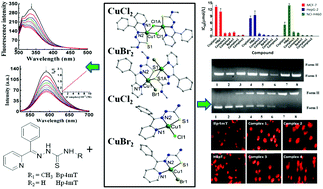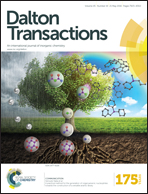Four Cu(ii) complexes based on antitumor chelators: synthesis, structure, DNA binding/damage, HSA interaction and enhanced cytotoxicity†
Abstract
Four novel copper(II) complexes [CuII(Bp4mT)(μ-Cl)]2 (1), [CuII(μ-Bp4mT)Br]2 (2), [CuII(HBpT)Cl] (3), and [CuII(HBpT)Br] (4) (Bp4mT = 2-benzoylpyridine-4-methylthiosemicarbazone, HBpT = 2-benzoylpyridine thiosemicarbazone), were synthesized and characterized using single-crystal X-ray diffraction, elemental analysis, infrared, and ultraviolet-visible spectroscopy. X-ray analysis revealed that complexes 1 and 2 based on the Bp4mT ligand presented dimeric structures in which the Cu(II) ions were located in a five-coordinated distorted square-pyramidal geometry, whereas both 3 and 4 complexes were mononuclear with the Cu(II) ions exhibiting a tetracoordinated square planar configuration. Their interactions with calf thymus DNA (CT-DNA) were investigated using viscosity measurements and fluorescence spectroscopy. Multispectroscopic evidence has shown interactions between these complexes and human serum albumin (HSA). All these complexes have exhibited efficient oxidative cleavage of supercoiled DNA in the presence of hydrogen peroxide, presumably via an oxidative mechanism. Furthermore, in vitro cytotoxicity studies of 1–4 against human liver hepatocellular carcinoma cells (HepG-2), human large cell lung carcinoma cells (NCI-H460), and human cervical carcinoma cells (HeLa) indicated their promising antitumor activity with quite low IC50 values in the range of 0.08–1.98 μM, which are 83 times lower than those of cisplatin. The mechanistic studies revealed that four complexes, which induced early apoptosis, were involved in reactive oxygen species generation and DNA cleavage for their antitumor activities.


 Please wait while we load your content...
Please wait while we load your content...